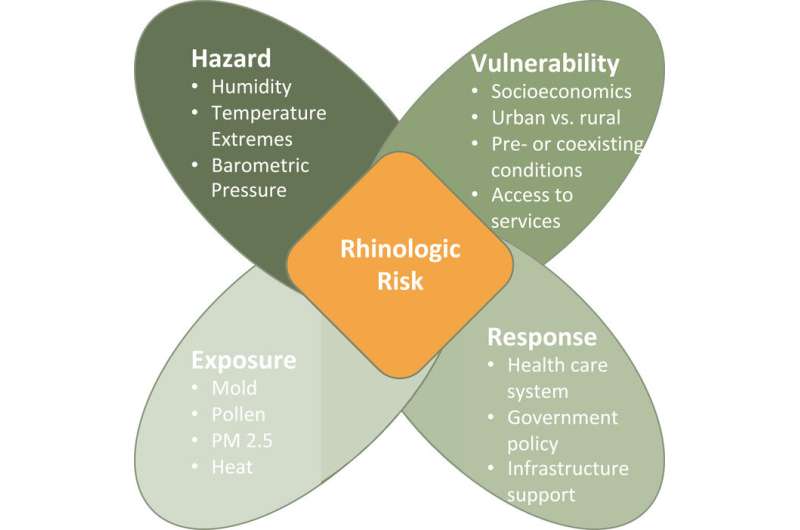The "risk propeller" applied to rhinologic disease. The "risk propeller" frequently used in Intergovernmental Panel on Climate Change reports, shown here with a four-blade structure was first introduced by Simpson et al. Risk is understood to be a product of interactions between climate hazards, exposures related to factors that put people in harm's way, vulnerabilities that predispose people or groups to adverse impacts, and responses that either mitigate or inadvertently exacerbate the risk of negative outcomes. Credit: International Forum of Allergy & Rhinology (2022). DOI: 10.1002/alr.23128
In a new review article, Johns Hopkins Medicine experts and collaborators across the U.S. emphasize that climate change—particularly global warming—is contributing to an increase in the rates and to greater severity of nasal and sinus diseases, such as seasonal allergies—conditions that affect 2 billion people worldwide.
The full review was published Dec. 28 in the journal International Forum of Allergy & Rhinology. Over 100 articles, spanning more than two decades of research, were selected for inclusion in the review.
The authors synthesized these studies to argue, and to add to already existing evidence, that rising and prolonged levels of humidity, increased levels of allergens (such as pollen), and delayed or early onset of seasons are contributing to a rising number of cases of allergic and nonallergic nasal and sinus diseases. These conditions include congestion and runny nose, chronic sinusitis and fungal sinus infections. The authors caution that health disparities among racial groups will widen gaps in health care access and exacerbate severity of these conditions.
The authors also advise using diverse and inclusive clinical and translational research approaches to design methods for diagnosis and treatment, as well as informing patients and the public about symptoms and treatments.
Corresponding and lead author Jean Kim, M.D., Ph.D., an associate professor and otolaryngologist at Johns Hopkins, says she and her collaborators view this article as a guide and call to action.
"Allergic and nonallergic diseases that affect the upper airways are gateway conditions to potentially more serious disorders of the respiratory system, including the diseases of the lower airways," says Kim. "We're hoping this will be a springboard for more collaboration among providers and our health care system so we can continue to advocate for these patients."
More information: Jean Kim et al, Climate change, the environment, and rhinologic disease, International Forum of Allergy & Rhinology (2022). DOI: 10.1002/alr.23128
Provided by Johns Hopkins University
























